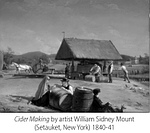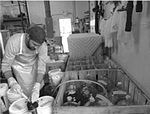CIDER RENAISSANCE
The Napa Valley arguably put America on the map as a respected wine producer but 100 years before the first grapevine was ever planted in California, the Hudson Valley and Northern New Jersey area was not only respected for its hard cider but it was considered among the finest in the world. The claim of producing the best cider is not as bold today as it was in early America where the average person consumed 35 gallons annually. Today a renaissance in hard cider-making and cultivating varieties that were once close to extinction is sweeping the region as people are learning the mass-marketed hard cider widely available today is a far cry from the drink of choice by early Americans.
Good cider apples, just like wine grapes, are prized for their high tannins and astringency that make them almost unpalatable for any other use. By pure luck, the apple trees planted in our area originally out of necessity flourished in perfect terroir and ideal growing conditions to produce apples suitable for cider. The dramatic changes in the seasons and soil conditions were not well suited to produce the balanced dessert apples we buy in the supermarket today - shiny and covered in a blanket of wax - but the conditions did produce fantastic cider apples completely different from their European counterparts. During the peak of production in the early 1800s, over 30,000 gallons were commercially produced in the region. German and Eastern European immigrants and their thirst for beer slowly brought this number down with an abrupt end on January 16, 1919 with the passage of the Volstead Act, more widely known as prohibition.
During the 20th century, apple production shifted to the West Coast thanks to urban sprawl and refrigerated rail cars. During this time period, countless apple varieties were lost or ignored to create the perfect-looking apple to sell to consumers. This period of homogenization was not isolated to the apple; countless other crop varieties were lost to industrial farming during this time. Many of the prime orchards in the region were mowed down to make room for housing and other more financially lucrative uses of the land. Of the thousands of varieties identified being commercially grown in the 1800s, the number fell to under 100 varieties during the mid-20th century
Newark Cider, the most prized blend and requested by name by George Washington, consists of a blend of four varieties: Poveshon, Campfield, Granniwinkle and Harrison. In the early 2000s the resurgence of interest in cider started a search for old specimens of these varieties previously thought to have been wiped out commercially by industrialization. Some varieties were found growing in other areas of the country but the Harrison and Poveshon varieties proved to be elusive. In 2015, a lawyer and amateur orchardist was in N.J. dropping off his daughter for marching band practice when he noticed apples hanging from a tree near an old cider mill, later identified as the celebrated Harrison variety. The Poveshon had a similar fate. Once thought to be extinct, the variety was found on a farm in upstate New York after the property owner read a magazine article describing the variety, which sounded familiar to him. His trees were eventually traced back to a New Jersey family.
Today, many of these original varieties are now commercially available to purchase, plant and with a little patience, produce the same apples once used to make what was considered the best hard cider in the world.



